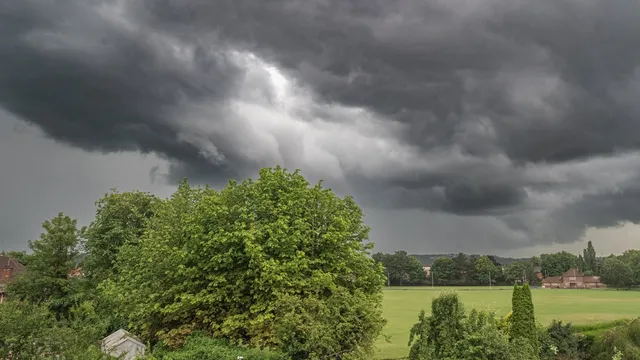
Severe thunderstorms raise tornado risk across UK
2025-06-23 09:45- The Met Office issued a yellow thunderstorm warning for northern England due to severe weather conditions.
- Temperatures in parts of the UK reached up to 34C, marking a significant heatwave.
- The combination of severe thunderstorms and potential tornado activity indicates changing climate patterns in the UK.
Express your sentiment!
Insights
In the United Kingdom, the Met Office issued a yellow thunderstorm weather warning, signaling potential tornado activity in northern regions. Weather conditions began to shift dramatically as a heatwave pushed temperatures up to 34C, making parts of England the hottest areas in the country. This warning was specifically issued for northern England, from Nottingham to Newcastle, effective from 5 PM until 3 AM the following day. Meteorologist Jonathan Vautrey emphasized that while tornadoes are rare, the conditions could align to allow for such an event as the severe storms approached. As the severe weather system formed, the Met Office expected intense thunderstorms, bringing with them frequent lightning, large hail, and the potential for flooding. The agency highlighted that the areas most likely to experience tornadoes would be those under the storm warning, particularly during the evening when the thunderstorms were anticipated to hit. This region's weather conditions were monitored closely, as Vautrey noted that the ingredients for tornado activity could come together, although it remains unpredictable where such a phenomenon may occur. In parallel, the weather forecast indicated a forthcoming change as cyclonic storms were expected to sweep through Scotland and northern England, causing temperatures to drop in these areas. This shift is part of a broader atmospheric response to the position of the jet stream, which has begun to redirect low-pressure systems towards northern Britain. While southern regions might still experience heat, the northern regions faced a significant shift towards colder, more unstable weather. The fluctuating weather patterns reflect changing climate conditions, with increasing occurrences of extreme heat and storms noted by climatologists and meteorologists. The heatwave preceding the severe weather was marked as the first of the summer season, with temperatures having reached notable highs in places like Charlwood, Surrey. The convergence of these weather systems not only heightened the risks for severe storms but also pointed to larger trends in the UK climate, prompting discussions of resilience and adaptation in response to the changing weather patterns.
Contexts
The impact of heatwaves on UK weather patterns has become increasingly significant, particularly in the context of climate change. Heatwaves, characterized by prolonged periods of excessively high temperatures, can alter usual weather patterns, leading to a range of environmental effects. In the UK, historical data shows that the frequency and intensity of heatwaves have risen over the past few decades, exacerbating the risks posed to various sectors, including agriculture, health, and infrastructure. The ramifications of these shifts can be profound, as higher temperatures can disrupt the delicate balance of ecosystems, resulting in altered biodiversity and increased vulnerability of species. The correlation between rising temperatures and the length of heatwaves illustrates the challenging climatic conditions facing the UK. Extreme heat events can lead to soil moisture depletion, negatively impacting crop yields and food security. For farmers, the unpredictability surrounding weather patterns complicates planning and resource management, as traditional growing seasons may no longer apply. Furthermore, the heat can affect livestock health, leading to diminished productivity and increased economic losses. This change in agricultural dynamics highlights the need for adaptive strategies to mitigate heatwave impacts, including improved irrigation techniques and crop diversification. Additionally, the health implications of rising temperatures during heatwaves are alarming. The UK experiences an increase in heat-related illnesses and mortality during these periods, particularly among vulnerable populations such as the elderly and those with pre-existing health conditions. Public health systems face the challenge of preparing for and managing the effects of prolonged heat on human health, requiring targeted interventions, such as heatwave early warning systems and community education campaigns. The potential for increased heatwaves necessitates a re-evaluation of public health strategies to better protect at-risk individuals and ensure the resilience of health systems. Lastly, the broader implications of sustained heatwave patterns on infrastructure cannot be ignored. Prolonged heat can strain transport networks, damage roads, and affect public utilities, leading to significant economic repercussions. With the increasing likelihood of extreme weather events, urban planning and infrastructure development must evolve to incorporate climate resilience measures. Creating infrastructure that can withstand higher temperatures, along with developing green spaces to mitigate urban heat effects, becomes essential to adapt to the changing climate landscape. In summary, the impact of heatwaves on UK weather patterns touches upon critical aspects of environmental, agricultural, health, and infrastructural domains, necessitating a coordinated response to address both immediate challenges and long-term implications.